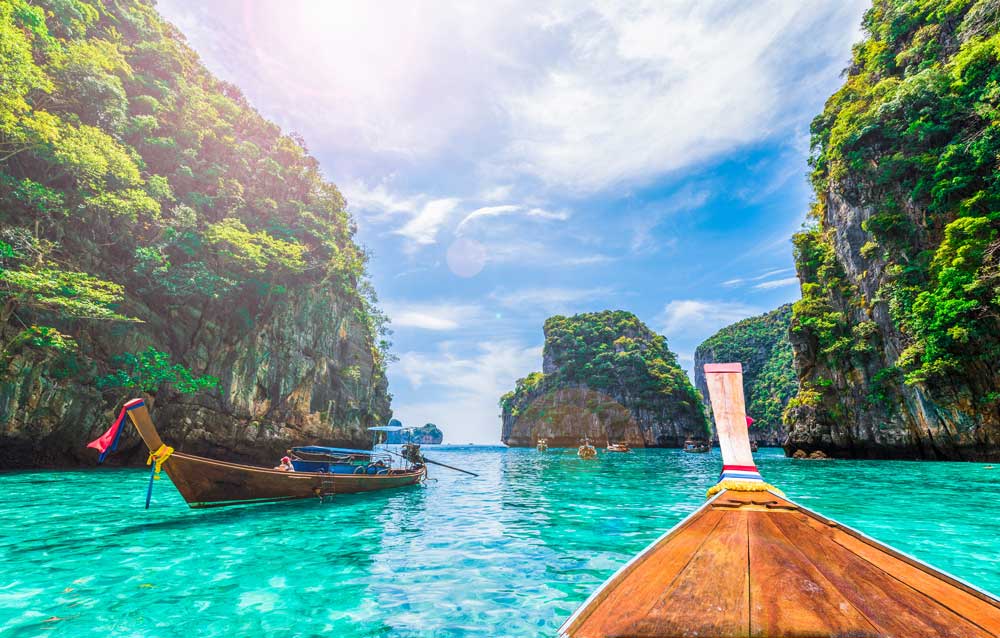
Phi Phi Liveaboard Diving: Tajlandia niezrównane wrażenia
Urok liveaboardów Phi Phi polega na możliwości budzenia się każdego dnia w tym tropikalnym raju, oddalonym od jednych z najbardziej urzekających miejsc do nurkowania na świecie. Liveaboards to mobilna baza, która zapewnia transport z jednego spektakularnego miejsca do nurkowania do drugiego, daleko poza zasięgiem jednodniowych wycieczek.
Przygoda na żywo z Phi Phi to niezapomniany sposób na zagłębienie się w klejnoty Morza Andamańskiego. Z gobelinem życia morskiego pod turkusowymi wodami i różnorodnymi miejscami do nurkowania, które zaspokajają potrzeby każdego nurka, Phi Phi jest obowiązkowym celem na liście każdego nurka.
O nurkowaniu Phi Phi Liveaboard
Morskie życie w Phi Phi jest różnorodne i obfite. Nurkowie mogą spodziewać się różnorodnych ryb rafowych, węgorzy, ośmiornic, a w razie szczęścia majestatycznych rekinów wielorybich i manty.
The Phi Phi Islands are a group of six islands located in the Andaman Sea, off the southwestern coast of Thailand. They are part of Krabi Province and are situated halfway between the island of Phuket and the mainland. The two main islands are Phi Phi Don and Phi Phi Leh, with the latter being famously featured in the movie " The Beach" starring Leonardo DiCaprio.
Historycznie wyspy były od dawna domem dla muzułmańskich rybaków, a później stały się plantacją kokosów. Nazwa „Phi Phi” pochodzi od języka malajskiego, a oryginalna nazwa wysp to „Pulao Pi ah Pi”, gdzie „pulao” oznacza wyspę, a „pi ah pi” to nazwa lasu namorzynowego tam znalezionego.
Wyspy po raz pierwszy zwróciły uwagę na międzynarodowy ruch turystyczny w latach 80., a ich popularność od tego czasu wzrosła dzięki oszałamiającym plażom, czystym wodom i tętniącemu życiem morskiemu. Pomimo znacznych szkód poniesionych podczas tsunami na Oceanie Indyjskim w 2004 r., Wyspy Phi Phi od tego czasu odbudowały się i pozostają głównym celem podróży turystycznych, znanym ze swojego niesamowitego piękna przyrody i bogatych podwodnych ekosystemów.
Witryny nurkowe Phi Phi
Bida Nok i Bida Nai
Zachwycające wapienne ściany, tętniące życiem ogrody koralowe i obfitość życia ryb. Zwróć uwagę na żarłacze lamparcie spoczywające na piaszczystym dnie, żółwie z wdziękiem poruszające się po miękkich koralowcach i ławice lucjanów tworzące stale zmieniający się gobelin.
Ściana Palong
Palong Wall słynie ze spotkań z rekinami, głównie z rekinami rafowymi pływającymi wzdłuż ściany, dodając adrenaliny do spokojnego podwodnego doświadczenia.
Maya Bay
Znana z filmu „Plaża”, Maya Bay jest nie tylko popularną górną atrakcją, ale także wspaniałym miejscem do nurkowania, zwłaszcza teraz, gdy podejmowane są wysiłki na rzecz zachowania jego naturalnego piękna.
Warunki nurkowe w Phi Phi
Wody Phi Phi są zazwyczaj spokojne i czyste, a ich widoczność waha się od 15 do 30 metrów, w zależności od pory roku. Temperatura wody wynosi 27-30°C, co pozwala na wygodne nurkowanie bez konieczności stosowania grubych kombinezonów.
Najlepszy czas na wizytę Phi Phi
Najlepszy czas na wejście na pokład promenady Phi Phi to listopad-kwiecień, podczas północno-wschodniej pory monsunowej, kiedy morza są najspokojniejsze, a widoczność w najlepszym wydaniu.
Wymagane doświadczenie w nurkowaniu
Większość liveaboardów Phi Phi zaspokaja potrzeby nurków na wszystkich poziomach doświadczenia, od początkujących po doświadczonych weteranów. Zaleca się jednak, aby nurkowanie na otwartej wodzie było komfortowe ze względu na możliwość wystąpienia prądów i głębokich nurkowań.
Jak do nas dojechaæ
Podróż do Phi Phi zazwyczaj rozpoczyna się lotem do Phuket lub Krabi, a następnie malowniczą przejażdżką promem na wyspy Phi Phi, gdzie wejdziesz na pokład swojego statku liveaboard.
Morskie życie w Phi Phi jest różnorodne i obfite. Nurkowie mogą spodziewać się różnorodnych ryb rafowych, węgorzy, ośmiornic, a w razie szczęścia majestatycznych rekinów wielorybich i manty. Miłośnicy makrofotografii będą zachwyceni poszukiwaniem koników morskich, nudibranch i krewetek wśród szczelin koralowych.
We're Here to Help 24/7






